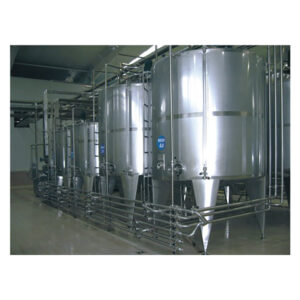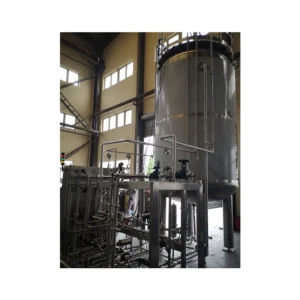A Complete Guide to the Aseptic Tanks: Features, Types, and Benefits
The Aseptic Tanks are essential piece of equipment for many food and beverage industries, especially those dealing with dairy, fruit juice, and beverages. Designed to store food products in an aseptic environment, this tank ensures that products remain free from contaminants before they are filled and packaged.
In this blog post, we’ll explore the technical features of the Aseptic Tank, the different types available, and the advantages it offers for food and beverage manufacturers.
What is an Aseptic Tank?
An Aseptic Tank is a specialized storage unit that is used to hold food products, such as fruit juices, dairy products, and other beverages, in a sterile environment. This tank is crucial in maintaining the quality and safety of the stored products before they are transferred to the packaging phase. The key benefit of using an aseptic tank is its ability to keep food products safe from microbial contamination, ensuring a longer shelf life and preserving flavor, texture, and nutritional value.

Why Choose an Aseptic Tank for Your Production Needs?
For industries that prioritize quality and hygiene, investing in an Aseptic Tank like the HTK-AT-01 model from FoodMachineryCH is a smart choice. It offers:
- High-quality construction using SUS304 and SUS316L stainless steel for durability and food safety.
- Ease of cleaning with a CIP (Clean-In-Place) cleaning ball, ensuring thorough sanitation.
- Advanced control systems such as a PLC Full-auto Control system, providing precise control over storage conditions.
- Customizable volume options ranging from 10T to 30T, tailored to fit various production needs.
Technical Features of the Aseptic Tanks
Below is a comparison table detailing the technical features of the HTK-AT-01 Aseptic Tank:
| Feature | Description |
|---|---|
| Product Name | Aseptic Tank |
| Model | HTK-AT-01 |
| Volume | 10T, 15T, 20T, 30T (Customized) |
| Material | SUS304 / SUS316L (Product contact parts SUS316L) |
| Minimum Order Quantity | One unit |
| Production Capacity | 20 units/month |
| Standard Components | Aseptic stirrer, aseptic pressure manway, CIP cleaning ball, ladder, handrail, guardrail, SIEMENS load scale, supporting leg, PLC Full-auto Control system |
| Control System | PLC Full-auto Control System for precise management |
The Aseptic Tank is made of high-grade stainless steel (SUS316L for product contact parts), ensuring it meets the stringent requirements of food hygiene standards. Its PLC-based control system enables automated and efficient operations, making it ideal for large-scale food and beverage production.
Different Types of Aseptic Tanks
Aseptic Tanks come in various types, each designed to meet specific needs. Here’s a comparison of different models based on volume and applications:
| Model | Volume | Application | Material |
|---|---|---|---|
| HTK-AT-01-10T | 10 Tons | Suitable for small-scale production | SUS304/SUS316L |
| HTK-AT-01-15T | 15 Tons | Ideal for medium-sized fruit juice storage | SUS304/SUS316L |
| HTK-AT-01-20T | 20 Tons | Versatile for both dairy and beverage storage | SUS304/SUS316L |
| HTK-AT-01-30T | 30 Tons | Best for large-scale operations | SUS304/SUS316L |
Key Advantages of the Aseptic Tanks
Using an Aseptic Tank in food and beverage processing comes with numerous benefits. Here are some of the key advantages:
- Superior Hygiene Standards
The Aseptic Tank is designed to meet strict food hygiene standards. Its seamless stainless-steel construction, free from dead corners, ensures that bacteria and other contaminants have no place to hide. This makes the cleaning process easy and guarantees that your products remain uncontaminated. - High-Quality Materials
Made with SUS316L stainless steel for parts that come into contact with the product, the Aseptic Tank offers excellent resistance to corrosion, making it suitable for acidic products like fruit juices. The use of SUS304 for other parts ensures robustness and longevity. - Customizable Volume
With volume options ranging from 10T to 30T, manufacturers can choose the capacity that best suits their production scale. This flexibility allows businesses to optimize storage according to their unique requirements. - Automated Control
The PLC Full-auto Control System ensures that the tank operates seamlessly, managing parameters such as pressure and temperature with precision. This feature minimizes manual intervention, reduces the risk of human error, and enhances overall productivity. - Durable and Robust Design
The Aseptic Tank’s design includes standard components like aseptic stirrers, a pressure manway, and support structures that guarantee stability during operation. The ladder and handrails add an extra layer of safety, making it user-friendly for maintenance staff.
Applications of the Aseptic Tanks in Food and Beverage Production
The Aseptic Tank finds its applications in a wide range of industries. Some of the key sectors that benefit from this equipment include:
- Dairy Industry: Essential for storing milk and other dairy products in a sterile environment before further processing and packaging.
- Juice Production: Maintains the freshness and flavor of fruit juices by preventing contamination before bottling.
- Beverage Manufacturing: Ideal for carbonated and non-carbonated beverages, ensuring that the taste and quality are preserved throughout storage.

How to Choose the Right Aseptic Tanks for Your Business
When selecting an Aseptic Tank, consider the following factors:
- Production Volume: Determine the volume you need based on your daily production levels. For example, a 10T tank may be suitable for smaller operations, while larger factories might require a 30T tank.
- Material Requirements: If your product is acidic or sensitive, opt for SUS316L stainless steel to ensure corrosion resistance and longevity.
- Automation Needs: If your production process is highly automated, the PLC Full-auto Control System can integrate seamlessly, providing reliable performance and reducing manual workload.
FAQs About Aseptic Tanks
Q1: What is the primary purpose of an aseptic tank?
A: An Aseptic Tank is designed to store food and beverage products in a sterile environment, keeping them free from microbial contamination before filling and packaging.
Q2: What materials are used in the construction of the Aseptic Tanks?
A: The tank is made with SUS316L stainless steel for parts that come into contact with the product, while other parts are constructed using SUS304 stainless steel.
Q3: How does the PLC Full-auto Control System benefit my production?
A: The PLC system automates the control of key parameters like pressure and temperature, ensuring consistent product quality and reducing the need for manual intervention.
Q4: Can the Aseptic Tanks be customized for different production needs?
A: Yes, the Aseptic Tank offers customizable volume options ranging from 10T to 30T, allowing it to adapt to varying production capacities.
Conclusion
The Aseptic Tanks are the important piece of equipment for food and beverage manufacturers seeking to maintain high standards of quality and hygiene. With its customizable options, robust design, and advanced automation features, it ensures that your products remain safe, fresh, and ready for packaging. Explore the different models of the HTK-AT-01 Aseptic Tank today and find the perfect solution for your production needs.


